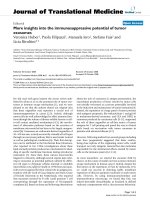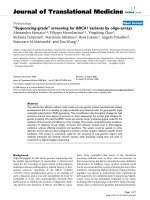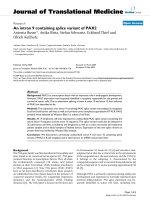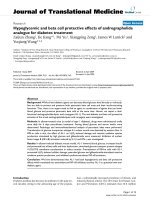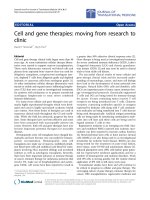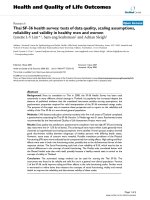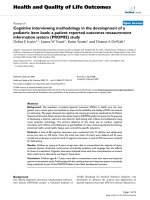báo cáo hóa học:" Open wedge high tibial osteotomy: cause of patellar descent" docx
Bạn đang xem bản rút gọn của tài liệu. Xem và tải ngay bản đầy đủ của tài liệu tại đây (236.4 KB, 22 trang )
This Provisional PDF corresponds to the article as it appeared upon acceptance. Fully formatted
PDF and full text (HTML) versions will be made available soon.
Open wedge high tibial osteotomy: cause of patellar descent
Journal of Orthopaedic Surgery and Research 2012, 7:3 doi:10.1186/1749-799X-7-3
Jason CH Fan ()
ISSN 1749-799X
Article type Technical Note
Submission date 4 March 2011
Acceptance date 12 January 2012
Publication date 12 January 2012
Article URL />This peer-reviewed article was published immediately upon acceptance. It can be downloaded,
printed and distributed freely for any purposes (see copyright notice below).
Articles in Journal of Orthopaedic Surgery and Research are listed in PubMed and archived at
PubMed Central.
For information about publishing your research in Journal of Orthopaedic Surgery and Research or
any BioMed Central journal, go to
/>For information about other BioMed Central publications go to
/>Journal of Orthopaedic Surgery
and Research
© 2012 Fan ; licensee BioMed Central Ltd.
This is an open access article distributed under the terms of the Creative Commons Attribution License ( />which permits unrestricted use, distribution, and reproduction in any medium, provided the original work is properly cited.
1
Open wedge high tibial osteotomy: cause of patellar descent
Jason CH Fan
Department of Orthopaedics & Traumatology, Alice Ho Miu Ling Nethersole Hospital,
Hong Kong SAR, People's Republic of China
Correspondence:
2
Abstract: This was a retrospective review of the nine open wedge high tibial
osteotomy (HTO) done in a regional hospital in Hong Kong from 2006 to 2008. The
mechanical hip-knee-ankle angle improved from average 169.5°(164°-175°) to
average 183.9° (179°–187°). Patellar descent was noted in all patients postoperatively,
with Blackburne-Peel (BP) index significantly changing from 0.78 (0.64-0.93) to 0.59
(0.38-0.78) (p<0.05). This change was strongly correlated with the size of anterior
bone graft (r= -0.766; p= 0.016). The patellar tendon length as measured by
Insall-Salvati index was not changed (pre-operative: 1.02 (0.88-1.25), final: 1.09
(0.8-1.22) (p=0.683)), inferring that scarring contracture of patellar tendon was not
related to patellar descent.
3
Introduction
High tibial osteotomy (HTO) has been well described as an effective procedure for
treatment of medial compartmental osteoarthritis of knee, especially in young and
active individuals. It could be done with barrel-vault osteotomy as decribed by
Maquet [1], or with closing-wedge osteotomy as suggested by Coventry [2], or with
open-wedge osteotomy as described by Hernigou [3]. The last one can be performed
on the medial side without any muscle detachment from the anterior tibial
compartment. The fibula and proximal tibiofibular joint are left intact, and therefore
the risk of peroneal nerve injury is minimal. The correction in both frontal and
sagittal planes can be fine-tuned intraoperatively [4]. The resultant tibio-condylar
offset is the least [5].
Patella baja is a well known complication after HTO. Kaper et al
reported that 54% of
46 knees that had undergone lateral closing-wedge HTO had lowering of patellar
height of greater than 10% [6]. It also occurred in open-wedge HTO. Actutally,
Brouwer et al showed that more patella baja was created after an open-wedge HTO
than after a closing-wedge HTO [7].
4
The aim of this study was to discuss the cause of patellar descent after open-wedge
HTO. The clinical outcome of the patients and the technical tips to achieve
satisfactory result would also be explained.
Materials and methods
Between July 2006 to August 2008, nine open-wedge HTO in six patients were done.
They included four female and two male patients. The mean age was 49 (37-53). Five
right knees and four left knees were operated. The inclusion criteria were medial
joint line pain and tenderness and minimal lateral compartment and patellofemoral
joint symptom. The knee flexion contracture was less than 10° and flexion range was
greater than 90°. Radiograph of knee showed varus deformity and predominant
narrowing of medial joint space while the lateral and patellofemoral joint spaces
were preserved. Exclusion criteria included tricompartmental osteoarthritis,
inflammatory arthritis, complete collateral deficiency, poor knee range outside that
stated above in the inclusion criteria and age older than 65 year-old. Moreover,
patients with significant tenderness of patellofemoral joint (PFJ) associated with
greater than 50% of PFJ narrowing shown in skyline radiograph of knee were also
excluded. Marginal osteophyte and cruciate ligament deficiency were not regarded as
5
exclusion factors.
Preoperative planning was done in a standing scanogram (Fig. 1). The planned
osteotomy cut in the frontal plane was determined by connecting a point 3 cm below
the medial joint line and another point just above the fibular head. Fujisawa line was
drawn by connecting femoral head center and another point at 30% lateral to center
of tibial plateau surface [8]. Next, a tracing of the portion of tibia distal to the
osteotomy was made. It was then superimposed on the radiograph and rotated
around the lateral pivot until the ankle center lied on the Fujisawa line. The amount
of medial opening was marked and measured. The new mechanical hip-knee-ankle
angle was then measured to make sure that it was about valgus three to six degrees
as suggested by Hernigou et al [3].
Operation was done using longitudinal incision about 1 cm medial to the patella
tendon. The pes anserinus was cut and part of the distal attachment of medial
collateral ligament was stripped. The space superior to the tibial tuberosity (TT) and
deep to the patellar tendon was developed. One Kirschner wire was inserted from
medial side along the line connecting TT upper border and the upper end of proximal
tibiofibular joint under x-ray control. Lateral x-ray was taken to locate the osteotomy
6
plane parallel to the joint surface. Another Kirschner wire was inserted at that plane
parallel to the first wire under x-ray control. Osteotomy was performed distal to the
wires initially by an oscillating saw, and then with osteotome, which stopped at about
5mm from lateral cortex, under x-ray control. Another osteotome was stacked onto
the first one to gradually spread the space open. Bone spreader was inserted to open
it further. Diathermy cable was placed along the line connecting hip and ankle
centers under x-ray control. X-ray of knee confirmed the cable passing through the
Fujisawa point and there was no lateral translation of distal segment. The open space
at the most posteromedial aspect was measured, which was the size of the corner
tricortical bone graft. While ensuring full knee extension, the sizes of anterior and
middle bone spaces were measured. Three pieces of tricortical bone graft were
harvested from the ipsilateral iliac crest, and then impacted into corresponding
places. 4.5mm T-plate was used to fix the osteotomy. Knee range of motion was
tested before wound closure. The knee was mobilized one day after operation. Six
weeks of non-weight bearing walking and another six weeks of partial weight bearing
walking were advised for healing of bone graft.
Postoperative assessment was undertaken at about three months and latest
follow-up. Mechanical hip-knee-ankle (HKA) angle and knee joint obliquity (Ob) were
7
measured in standing scanogram. Insall-Salvati (IS) index [9], Blackburne-Peel (BP)
index [10] and posterior tibial slope as measured by Moore and Harvey (MH) method
[11] were obtained in lateral knee radiograph in at least 30° flexion.
From the medical records, the preoperative and the latest clinical data were obtained,
including the bone graft size, follow-up period, knee range, clinical symptom and
Knee Society knee score [12]. Hernigou et al reported that the best result of HTO was
to achieve mechanical HKA between 183° and 186° [3]. Knee society knee score was
modified in the alignment part. If the HKA was between 183° and 186°, zero point
was deducted. From 174° to 182° and from 187° to 195°, two points was deducted for
every degree beyond the ideal range. For the other alignment, 20 points was
deducted. Student t-test was used to compare preoperative, 3-month and latest
value of HKA, Ob, IS index, BP index and MH slope. The relationship between
different variables was calculated by linear regression method, and reported in
Pearson’s correlation (r) and significance (p). The Statistical power analysis for the
correlation between anterior bone graft (ABG) size, posterior bone graft (PBG) size,
BP change and IS change was done by computer software GPOWER.
8
Results
The mean follow-up period was 19.6 months (11-36). The sizes of anterior and
posterior bone grafts were 5.4mm (4-7) and 16.3mm (11-20) respectively. Table 1
showed the preoperative, 3-month and latest data of IS index, BP index, mechanical
hip-knee-ankle angle, joint obliquity and MH slope. Besides IS index and MH slope,
when comparing the 3-month data and the latest data with the preoperative data,
the p-values were all <0.05, indicating statistically significance. Preoperative IS index
was similar to those at 3-month and in the latest follow-up (p=0.463 and p=0.3). MH
slopes before operation were similar to those at 3-month and in the latest follow-up
(p=0.872 and 0.536). For the comparison of all variables between 3-month data with
the latest data, all differences were statistically insignificant.
In case of intact patellar tendon, IS index actually measured the ratio of patellar
tendon length to the diagonal length of patella, which thus cancelled the effect of
radiographic magnification. While BP index measured the ratio of perpendicular
distance of lower edge of patellar articulation from the tibial plateau to length of
patella articular surface, it could better reflect the patellar height. The effect of sizes
of anterior and posterior bone graft, and MH Slope on the patellar tendon length and
9
patellar height was separately correlated. Only the size of anterior bone graft (ABG)
was significantly but inversely correlated with change of patellar height (r=-0.766;
p=0.016). The posterior bone graft (PBG) size and change of MH slope were not
correlated with change of BP index. For the change of patellar tendon length, the
correlations of ABG, PBG and change of MH slope were not statistically significant
(Table 2).
There was no flexion contracture before and after operation. The preoperative
flexion was 123.3°(110°-125°) and the postoperative flexion was
118.3°(100°-125°)(p=0.22). The function score improved from 57.8(50-90) to
80(45-100), and the knee score increased from 45.4(35-52) to 87.1(70-100). They
were statistically significant (p<0.05). The final function and knee scores were not
correlated with the latest BP index (r=-0.214, p=0.58; r=0.036, p=0.928 respectively).
One patient had displacement of posterior bone graft and loss of corrected
alignment at one week after operation. Reoperation with bone graft reposition and
internal fixation was necessary. There was no complication of wound infection,
hematoma, compartment syndrome, intraoperative fracture of tibial plateau
fragment or neurovascular injury.
10
Discussion
The average longevity of a HTO has been estimated to be about six to seven years,
with conversion to total knee arthroplasty (TKA) occurring in about 20% of patients
after 5 years, 40% after 10 years, and 60% after 15 years [6]. Patella baja, change of
tibial slope and valgus alignment after HTO can all cause technical difficulties during
TKA, particularly in relation to eversion of patella, exposure of the lateral
compartment, and placing the tibial component in the correct position both for
rotation and slope [7].
In the present study, patella descent occurred in all knees early after HTO, with the
BP index decrease from 0.78 to 0.55. The patellar height was maintained until the
latest follow-up, with BP index of 0.59. The BP indexes of three knees (0.38, 0.44 &
0.49) were outside normal range (0.54-1.06) and were defined as patella baja. The
patella tendon length was insignificantly increased early after operation. It was
maintained until the latest follow-up. This pointed to a structural cause of patellar
descent, rather than a biological cause due to scarring. Moreover, the size of ABG
was found to be significantly but inversely related to the BP index change. The larger
11
the ABG, the larger was the patella descent, the smaller was the latest BP index, and
the more negative would be the BP change. Rigid fixation and early mobilization in
the present cases could minimize the patellar tendon scarring. This echoed the idea
of Brouwer et al that elevation of the tibial plateau after open-wedge osteotomy was
one of the cause of patella baja [7]. Alteration of tibial slope was reported to affect
the patellar height [6,7]. It could not be concluded in the present study (r=0.204,
p=0.599). Moreover, the patellar height was not found to be correlated to the final
functional and knee score.
Tibial slope in the current study was reported by the method of Moore and Harvey
[11] because lateral radiograph of the whole tibia was not available to draw the
mechanical tibial axis. Moreover, it was reproducible in the lateral knee radiograph
by using the anterior tibial cortex and tibal plateau surface as landmarks. The
posterior tibial slope was not significantly altered after HTO. It was maintained after
complete union of bone graft in the latest follow-up. A few factors contributed to the
success. Osteotomy cut was confirmed by x-ray to be parallel to the tibial plateau
surface. The knee was kept in full extension when measurement of bone graft sizes
was done, and also during the fixation of osteotomy by plate. Lateral x-ray of the
contralateral knee was obtained to compare the tibial slope. If there was pre-existing
12
knee flexion contracture and the osteotomy was used to correct that deformity, the
posterior tibial slope would be diminished.
Over-correction of coronal valgus alignment was important to obtain satisfactory
result after HTO [3,13]. Hernigou et al reported that the best results were obtained in
20 cases of open-wedge HTO that had mechanical hip-knee-ankle angle of 183° to
186° [3]. There was no pain and no progression of the arthrosis in either the medial
or the lateral tibiofemoral compartment. Aglietti et al reported the results of 91
closing-wedge HTO [13]. An anatomical valgus alignment at consolidation between 8°
and 15° was significantly correlated with the best result. In the current study, the
former recommendation was followed because it was more stringent and
open-wedge HTO was performed. In this way, the Knee Society knee score was also
modified because the target range in HTO was different from that in TKA. The
mechanical coronal alignment was significantly corrected from varus 10.5° to valgus
4.4°. At consolidation of bone graft, it was maintained at valgus 3.9°. The varus
recurrence was minimal and not significant. Six out of nine knees could achieve the
target alignment. One knee had varus 1° and the patient had minimal knee pain and
his knee score was 86 at 24 month follow-up. Two knees had valgus 7° and the
patients had no knee pain. One of their knee scores was 98 at 36 month follow-up
13
and the other was 87 at 27 month follow-up. In order to achieve the target alignment,
a few points were important, including accurate preoperative planning, careful
prevention of lateral tibial translation on opening up the osteotomy and
measurement of bone graft size, harvesting graft larger than measured size to allow
down-trimming and rigid internal fixation.
The normal knee joint has varus 3° obliquity. The preoperative value of the present
cases was varus 5.5° (2°-10°) (p=0.023). It indicated significant medial compartment
bone loss. It was changed to valgus 7.7°(4°-11°) at bone graft consolidation. One knee
had valgus 11°. Hernigou et al found that their maximum postoperative obliquity was
10° [3]. After follow-up of eleven years, no medial subluxation of tibia was noted.
The knee range of motion was not altered significantly after HTO, while the function
and knee scores were significantly improved. Only one patient had deterioration of
function score after HTO. His function score was 60 before his left HTO, which
ameliorated his left knee pain. He had exacerbation of right knee pain and the
function score was 55 before his right HTO at about eight months later. In the most
recent follow-up at 22 months after first HTO, the function score decreased to 45.
The latest HKAs were 183° and 185° and the knee scores changed from 47 and 45 to
14
75 and 70 for right and left sides respectively. He had exacerbation of bilateral
patellofemoral joint pain related to increasing osteoarthritic change, which affected
the knee score. In addition, he had bilateral calves pain related to spinal problem,
which affected his functional status. This last case exemplified the importance of
patient selection in achieving good postoperative result. Even with ideal alignment,
postoperative knee pain exacerbation and functional deterioration could happen.
Conclusion
Patellar descent was common after open-wedge HTO. It was found to be correlated
with the size of anterior bone graft. In order to achieve satisfactory coronal and
sagittal alignment, it was important to avoid the pitfalls and adhere to some of the
technical details. Meticulous patient selection was also important in order to ensure
that the good postoperative result could be maintained.
15
Competing interests
The author declares that he has no competing interests.
Author contribution
JCHF carried out the operation, did the data collection and analysis and wrote the
manuscript.
16
References
1. Maquet P. Vaglus osteotomy for osteoarthritis of the knee. Clin Orthop 1976;
120: 143-8
2. Coventry MB. Osteotomy about the knee for degenerative and rheumatoid
arthritis: indications, operative technique and results. J Bone Joint Surg 1973;
55A: 23-48
3. Hernigou PH, Medevielle D, Debeyre J, Goutallier D. Proximal tibial osteotomy
for osteoarthritis with varus deformity. J Bone Joint Surg 1987; 69A: 332-54
4. Lobenhoffer P, Agneskirchner JD. Improvements in surgical technique of valgus
high tibial osteotomy. Knee Surg Sports Traumatol Arthrosc 2003; 11: 132-8
5. Nakamura E, Mizuta H, Kudo S, Takagi K, Sakamoto K. Open-wedge osteotomy of
the proximal tibia with hemicallotasis. J Bone Joint Surg 2001; 83B: 1111-5
6. Kaper BP, Bourne RB, Rorabeck CH, Macdonald SJ. Patellar infera after high tibial
osteotomy. J Arthroplasty 2001; 16:168-73
7. Brouwer RW, Bierma-Zeinstra SMA, Van Koeveringe AJ, Verhaar JAN. Patellar
height and the inclination of the tibial plateau after high tibial osteotomy. The
open versus the closed-wedge technique. J Bone Joint Surg 2005; 87B(9),
1227-32
17
8. Fujisawa Y, Masuhara K, Shiomi S. The effect of high tibial osteotomy on
osteoarthritis of the knee. An Arthroscopic study of 54 knee joints. Orthop Clin.
North America 1979; 10: 585-608
9. Insall J, Salvati E. Patella position in the normal knee joint. Radiology 1971; 101:
101-4
10. Blackburne JS, Peel TE. A new method of measuring patellar height. J Bone Joint
Surg 1977; 59B: 241-2
11. Moore TM, Harvey JP Jr. Roentgenographic measurement of tibial plateau
depression due to fracture. J Bone Joint Surg 1974; 56A: 155-60
12. Insall JN, Dorr LD, Scott RD, Scott WN. Rationale of the Knee Society clinical
rating system. Clin Orthop 1989; 248: 13-4
13. Aglietti P, Buzzi R, Vena LM, Baldini A, Mondaini A. High tibial valgus osteotomy
for medial gonarthrosis: a 10- to 21-year study. J Knee Surg 2003; 16(1): 21-6
18
Figure legend
Figure 1. i) Preoperative planning. A: femoral head center; AB: Fujisawa line; C: ankle
center; D: Pivot point. Tibial shaft tracing distal to DC1 rotated laterally until point C
lying on line AB, DC1 intersected medial tibial cortex to form point B1. C1B1 was the
size of posteromedial bone graft. ii) Postoperative radiograph. Line AC intersected the
knee joint at 30% lateral to knee center.
19
Table 1. Data indicating the patella tendon length (IS index), patella position related
to joint surface (BP index), Coronal knee alignment (HKA and Joint Ob) and sagittal
alignment (MH slope). Var: varus; Val: valgus. Positive value of MH slope indicated
posterior slope.
Mean(range) Preoperation 3-month Latest Fu
IS index 1.02 (0.88-1.25) 1.06 (0.9-1.28) 1.09 (0.8-1.22)
BP index 0.78 (0.64-0.93) 0.55 (0.42-0.67)* 0.59 (0.38-0.78)*
HKA (°) 169.5 (164-175) 184.4 (179-188)* 183.9 (179-187)*
Joint Ob (°) Var 5.5 (2-10)@ Val 7.3 (2-13)* Val 7.7 (4-11)*
MH slope (°) 10.9 (5-15) 10.6 (4-18) 11.8 (8-16)
* p<0.05 when compared with preoperative data. @ p=0.023 when compared with
normal var 3°.
20
Table 2. Linear regression reported the Pearson’s correlation (r) and significance (p
value) of the relationship between anterior bone graft (ABG) size, posterior bone
graft (PBG) size, Moore-Harvey (MH) slope change and Blackburne-Peel (BP) index
change and Insall-Salvati (IS) index change. MH Change, BP change and IS change
were calculated by preoperative data subtracted from latest data. Statistical power (P)
was calculated by GPOWER.
ABG size PBG size MH slope change
BP change r = -0.766 r= -0.122 r= 0.204
p= 0.016*; P=1 p= 0.755; P=1 p= 0.599
IS change r= -0.474 r= -0.111 r= -0.261
p= 0.198; P=1 p= 0.775; P=1 p= 0.498
* Statistically significant
Figure 1
